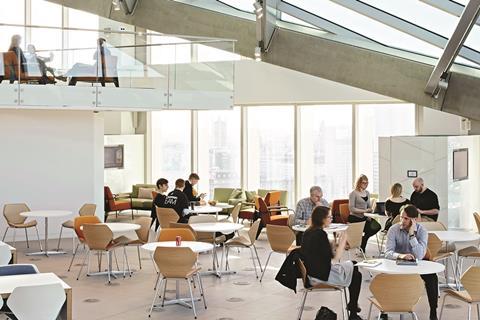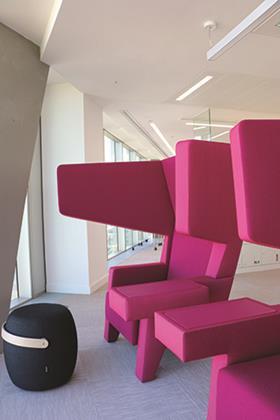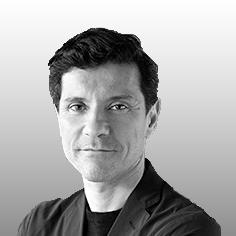The designer behind the interiors of Building’s new home explains the thinking behind designing an office for the workforce of the millenials’ generation

This week Building moved in to its new home at 240 Blackfriars Road on London’s South Bank. Developed by a JV between Great Portland Estates and BP Pension Fund, designed by Allford Hall Monaghan Morris, and built by Mace, the angular 19-storey glass and steel tower is the latest high-profile addition to this increasingly busy part of the capital.
Building’s publisher, UBM, is the anchor tenant of the building and has leased nine of the tower’s upper levels, including the double-height atrium which houses the cafe and meetings rooms on the top floor. Engineer Ramboll is one of the building’s other tenants.

The tower has been designed from the start using BIM, with computer models coming in particularly handy in fitting the building’s complex services into a relatively compact space. It also meets the BREEAM “excellent” standard, which entailed a major redesign of the facade and services to incorporate changes to the standard made in 2011.
Architect Gensler has been employed by UBM to design the interior of its workspace. The publisher and events company has opted for an “agile working” hot-desking environment, in which employees book the desk or meeting area they will work in when they enter the building. Desks are cleared each day to facilitate flexibility, which is enhanced by a range of different types and sizes of meeting spaces. The building is crowned with a two-storey top floor events space, complete with a raised viewing platform to truly appreciate the breathtaking views over London.
Below Gensler describes the thinking behind this new way of working for the firm.
Project Team
Client / developer The Great Ropemaker Partnership (JV between GPE and BP Pension Fund)
Architect Allford Hall Monaghan and Morris
Interior architect Gensler
Structural engineer AKT II
M&E engineer Hilson Moran
QS Davis Langdon/Aecom
PM / CDM-C Jackson Coles
BIM coordinator BIM.Technologies
Main contractor Mace

Think beyond the desk
Enrico Caruso
The design of the workplace has always paralleled the changes taking place in the world of business. This ranges from the process-focused approach seen in the 1980s through to the more nuanced 21st century appliance of design that considers the intersection of process, technology and people. Offices must be designed with the ability to support changing work patterns, market forces and environmental imperatives in order to succeed. Perhaps the creation of a properly balanced workplace, one that caters for a variety of working styles needed throughout a typical day, has not happened rapidly enough - and that is what we tried to create in our design for UBM, the publisher of Building magazine.
An exciting new shift in the way we view our workplace environment is on the horizon. The office will still be a key component of our working lives for quite some time yet. However, as the millennial generation comes into its own in the workforce, the expectations for what they want in a workplace are rapidly changing the dynamics of space. They are seeking a blend of culture, brand, and experiential working environments. But why?
As the competition for top talent increases, employers are exploring ways to attract and retain the best and the brightest. Among many leading organisations there is a growing recognition that the physical workplace can be a key to providing engaging and atypical work experiences that the next generation of workers so desperately seek.
A well designed workplace not only helps retain employees, it enhances productivity and engagement. According to Gensler’s 2012 Workplace Survey, four in five professionals maintain that the quality of their working environments is very important to their sense of job satisfaction, yet a vast majority don’t believe their office has been designed to support their company’s business or their own job function.
The integration of modern technology was critical to the success of the workspace and will transform the working life of a UBM employee from the moment they step in the building
Across all age groups, there is a growing desire for choice, autonomy and flexibility in the workplace with spaces dedicated to intense periods of focus, team work, collaboration and socialisation.
The right alignment of these tools, policies and spaces is an opportunity for companies to create an environment in which employees can make meaningful decisions to maximise their performance. This has led to a steady shift away from just looking at efficiency, for instance, minimising empty desks with hot-desking, and instead a focus on effectiveness, leading employees and employers to think beyond their desks.
From its brief to us it appeared UBM understood this. Its new London headquarters provided an opportunity for the company to express its multinational brand and core values, and UBM approached Gensler to create a space that embraced the next generation of forward thinking office space. By opting for an agile working and open-plan format, UBM adopted a workplace that encourages autonomy while simultaneously fostering collaboration based on job roles rather than hierarchy.
The need to support innovation here produced an open, fluid and flexible work setting. Working anytime and anywhere is now the norm, and the environment supports this through a variety of shared spaces, or as we like to call it “Generation Share” (Generation S) spaces, which support all types of work-mode choices.
The integration of modern technology was critical to the success of the workspace and will transform the working life of a UBM employee from the moment they step in the building.
For example, digital archiving enables UBM’s new paper-lite system, while daily desk booking, mobile equipment and smart lockers activated with entry cards help staff move effectively throughout their new space.
Gensler’s main priority was ensuring that the energy and spirit of UBM was accurately captured, culminating in the top floor events space, which has exquisite views overlooking the city. This provides the company with the choice to hold events in-house, which it was unable to do before.
UBM’s open plan office and flexible working space provides the creative work environment needed to foster innovation and to allow the firm to compete in the digital age.
Enrico Caruso is principal at Gensler Architects, and project principal of the UBM project




























No comments yet